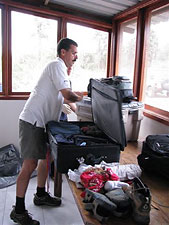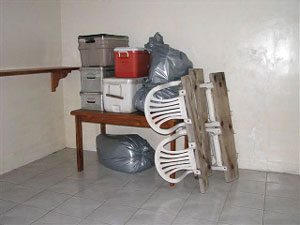

 | |||||||||||||
|
|
Journals 2008/2009Tom Bogard
September 2, 2008 I met Mark Gardner, one of the directors of the Station. One of the topics that we discussed was the state of the ocean around the islands. He said that the sea was the roughest that he has seen in years. So rough in fact that he was concerned about our use of the panga (remember that it is a small open boat) during the survey. Great, it will be like being tossed around like a cork, even on the "big" boat. I am sure that it will all be part of the adventure. Mark introduced me to Sharon Deem, a wildlife veterinarian from the St Louis Zoo. Dr. Deem is tracking the spread of an outbreak of plasmodium, Avian Malaria, in Galapagos Penguins. I volunteered to help her tomorrow to prepare penguin blood samples for shipment back to her lab in the United States. Quarantine! The purpose of quarantine procedure is to prevent the spread of organisms, both plant and animal, from one island to another. Because of their isolated development each of the islands is biologically unique. The species from island to island are similar and originated from common ancestors; their populations being isolated they drifted into separate species over time. For quarantine each of the participants on the expedition had to bring their clothes and equipment to the quarantine station for inspection and sealed storage. Every bag and article was thoroughly inspected for soil, seeds, and insects. Areas of particular concern were seams in clothing and bags, soles of shoes, and Velcro. These are areas where seeds and insects can hide and latch on. Once the inspection was complete shoes were sprayed with a low toxicity, plant based, insecticide, and all items were sealed in large plastic trash bags. Equipment was placed in coolers or metal boxes with tight fitting lids and the lids were taped shut. All items were then placed in specially designed sealed quarantine room, which was then locked. All of this had to be completed 48 hours prior to departure. I was allowed to keep the clothes I was wearing, a change of underwear, toothbrush/toothpaste, and some of my camera equipment (as long as I promised to thoroughly clean and inspect it just before departure).
|
||||||||||||

